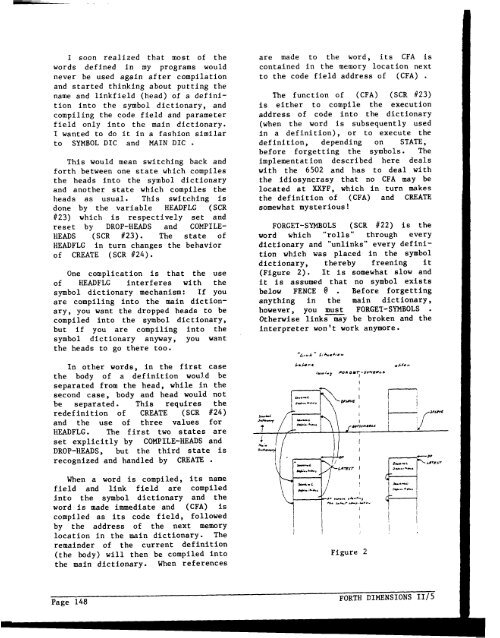5 - Forth Interest Group
5 - Forth Interest Group
5 - Forth Interest Group
Create successful ePaper yourself
Turn your PDF publications into a flip-book with our unique Google optimized e-Paper software.
I soon realized that most of the<br />
words defined in my programs would<br />
never be used again after compilation<br />
and started thinking about putting the<br />
name and linkfield (head) of a defini-<br />
tion into the symbol dictionary, and<br />
compiling the code field and parameter<br />
field only into the main dictionary.<br />
I wanted to do it in a fashion similar<br />
to SYMBOL DIC and MAIN DIC .<br />
This would mean switching back and<br />
forth between one state which compiles<br />
the heads into the symbol dictionary<br />
and another state which compiles the<br />
heads as usual. This switching is<br />
done by the variable HEADFLG (SCR<br />
1/23) which is respectively set and<br />
reset by DROP-HEADS and COMPILE-<br />
HEADS (SCR //23). The state of<br />
HEADFLG in turn changes the behavior<br />
of CREATE (SCR 624).<br />
One complication is that the use<br />
of HEADFLG interferes with the<br />
symbol dictionary mechanism: If you<br />
are compiling into the main diction-<br />
ary, you want the dropped heads to be<br />
compiled into the symbol dictionary,<br />
but if you are compiling into the<br />
symbol dictionary anyway, you want<br />
the heads to go there too.<br />
In other words, in the first case<br />
the body of a definition wou1.d be<br />
separated from the head, while in the<br />
second case, body and head would not<br />
be separated. This requires the<br />
redefinition of CREATE (SCR 624)<br />
and the use of three values for<br />
HEADFLG. The first two states are<br />
set explicitly by COMPILE-HEADS and<br />
DROP-HEADS, but the third state is<br />
recognized and handled by CREATE .<br />
When a word is compiled, its name<br />
field and link field are compiled<br />
into the symbol dictionary and the<br />
word is made immediate and (CFA) is<br />
compiled as its code field, followed<br />
by the address of the next memory<br />
location in the main dictionary. The<br />
remainder of the current definition<br />
(the body) will then be compiled into<br />
the main dictionary. When references<br />
are made to the word, its CFA is<br />
contained in the memory location next<br />
to the code field address of (CFA) .<br />
The function of (CFA) (SCR 1/23)<br />
is either to compile the execution<br />
address of code into the dictionary<br />
(when the word is subsequently used<br />
in a definition), or to execute the<br />
definition, depending on STATE,<br />
before forgetting the symbols. The<br />
implementation described here deals<br />
with the 6502 and has to deal with<br />
the idiosyncrasy that no CFA may be<br />
located at XXFF, which in turn makes<br />
the definition of (CFA) and CREATE<br />
somewhat mysterious!<br />
FORGET-SYMBOLS (SCR 1/22) is the<br />
word which "rolls" through every<br />
dictionary and "unlinks" every defini-<br />
tion which was placed in the symbol<br />
dictionary, thereby freening it<br />
(Figure 2). It is somewhat slow and<br />
it is assumed that no symbol exists<br />
below FENCE @ . Before forgetting<br />
anything in the main dictionary,<br />
however, you must FORGET-SYMBOLS .<br />
Otherwise links may be broken and the<br />
interpreter won't work anymore.<br />
Figure 2<br />
Page 148 FORTH DIMENSIONS II/5
















